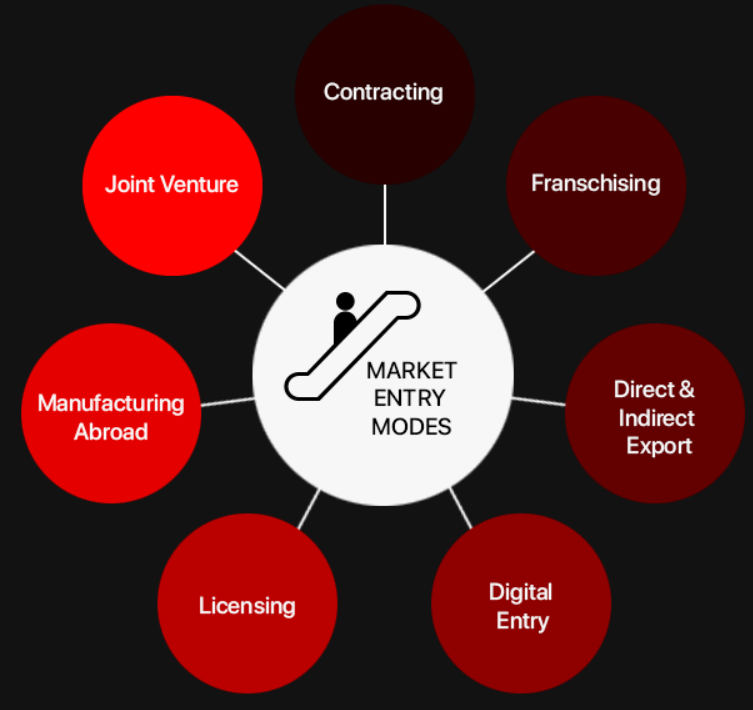Market Entry Tactics
What are Market Entry Tactics
Definition:
Market Entry Tactics refer to the specific actions and approaches that companies employ to enter and establish a presence in new markets or industry segments. These tactics are designed to capitalize on opportunities, navigate challenges, and effectively penetrate unfamiliar territories to achieve business objectives and drive growth.
Analogies:
Think of Market Entry Tactics as different tools in a builder’s toolkit. Just as builders use various tools to construct a structure, businesses utilize different tactics strategically to enter new markets, leveraging each tactic’s unique strengths to overcome barriers and lay a solid foundation for growth.
Further Description:
Market Entry Tactics encompass a wide range of strategies tailored to the specific needs, characteristics, and objectives of each market entry initiative. These tactics may include product adaptation, strategic partnerships, distribution channel optimization, pricing strategies, promotional campaigns, and regulatory compliance measures, among others.
Why are Market Entry Tactics Important?
Market Entry Tactics are critical for businesses seeking to expand their reach and tap into new market opportunities. They enable companies to:
- Maximize Opportunity: By deploying targeted tactics, businesses can capitalize on emerging trends, unmet needs, and underserved segments within new markets, unlocking revenue streams and driving business growth.
- Minimize Risk: Thoughtfully designed tactics help mitigate risks associated with market entry, such as regulatory compliance issues, cultural barriers, competitive pressures, and resource constraints, reducing the likelihood of setbacks or failures.
- Enhance Competitiveness: Effective market entry tactics allow companies to differentiate themselves, establish brand presence, build customer loyalty, and gain a competitive edge in new markets, positioning them for long-term success and sustainability.
Key Components of Market Entry Tactics:
– Product Localization: Adapt products or services to suit local market preferences, cultural nuances, regulatory requirements, and consumer behaviors, ensuring relevance and resonance with target audiences.
– Partnership Development: Forge strategic alliances, joint ventures, distribution agreements, or licensing arrangements with local partners, suppliers, distributors, or industry players to leverage their expertise, networks, and resources for market entry.
– Market Segmentation: Identify and target specific customer segments or niche markets with tailored offerings, messaging, and value propositions that address their unique needs, pain points, and preferences.
– Distribution Channel Optimization: Optimize distribution channels and routes to market, leveraging existing infrastructure, e-commerce platforms, retail networks, or third-party distributors to maximize reach, accessibility, and efficiency.
– Promotional Campaigns: Develop targeted marketing and promotional initiatives, including advertising, PR, social media, content marketing, influencer partnerships, and experiential events, to raise awareness, generate interest, and drive demand for products or services.
– Regulatory Compliance: Ensure compliance with local laws, regulations, trade policies, and industry standards governing product safety, labeling, packaging, intellectual property rights, data privacy, and environmental practices to mitigate legal and reputational risks.
Tips for Implementing Market Entry Tactics:
- Strategic Planning: Conduct comprehensive market research and analysis to inform tactical decision-making, identify competitive advantages, assess market readiness, and set clear objectives and benchmarks for success.
- Flexibility and Adaptability: Remain agile and responsive to evolving market dynamics, customer feedback, and competitive pressures, adjusting tactics as needed to optimize performance and capitalize on emerging opportunities.
- Resource Allocation: Allocate resources strategically, balancing investment priorities, timelines, and budget constraints to support tactical execution effectively and achieve desired outcomes within established parameters.
- Continuous Evaluation: Monitor and evaluate the effectiveness of market entry tactics through key performance indicators (KPIs), metrics, and feedback mechanisms, iterating and refining strategies based on performance insights and lessons learned.
- Long-Term Perspective: Maintain a long-term perspective and commitment to market development, nurturing relationships, building brand equity, and fostering customer loyalty over time to sustain growth and competitiveness in new markets.
Key Takeaways:
– Market Entry Tactics are strategic actions and approaches used by businesses to enter and establish a presence in new markets or industry segments.
– Effective market entry tactics involve product localization, partnership development, market segmentation, distribution channel optimization, promotional campaigns, and regulatory compliance measures.
– Successful implementation of market entry tactics requires strategic planning, flexibility, resource allocation, continuous evaluation, and a long-term perspective to navigate complexities, capitalize on opportunities, and drive sustainable growth in new markets.
Table of Contents





